3/1/2020
Best of the Best From the Winter Shows
Chris Beytes & Jennifer Zurko
IPM Essen
Looking back on the 38th International Plant Fair IPM Essen, it was four very successful days at the fair: From January 28 to 31, a total of 1,538 exhibitors from 46 countries presented their innovative products and services in the Plants, Technology, Floristry and Garden Features areas.
Messe Essen was once more the most important meeting place of the worldwide green sector. Over 54,000 (in 2019: 52,800) visitors from over 100 countries obtained information about trends and ordered goods for the coming season. More than ever, climate change and sustainability were the dominant subjects at the world's leading fair for horticulture.
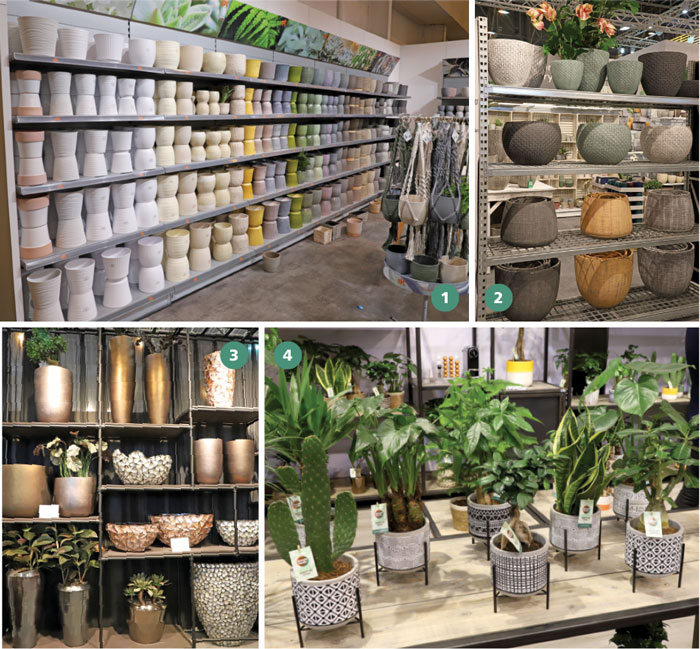
What’s Trending in Colors and Textures?
1-4: Based on what we saw in displays, and from talking to exhibitors, popular color choices remain neutral and matte. Gray, earth tones, black and white dominate the color schemes, with accents of green, pink, purple, yellow and a few other colors popped in for interest. Metals tend toward buff, not shiny. Textures remain coarse and tactile: concrete, natural stone, ridges, ribs and geometric patterns. And, yes, we saw a bit of ’70s-style macramé to go along with the abundant greenery.
5-6: German pot manufacturer Scheurich offered up some bold and colorful patterns for 2020, including Art Deco and Tropicana.
Transparent Green PET
7: The search for environmentally friendly packaging continues, as growers seek ways to reduce their use of plastic packaging at the same time as plastic pot manufacturers seek ways to make products that will go through community recycling streams. To that end, Modiform has developed an attractive Transparent Green PET (polyethylene terephthalate; better known as polyester when used in clothing) packs. They’re made from 100% post-consumer recycled plastic and are said to be detectable by the infrared systems being used in many recycling systems. I asked about plant growth in the translucent plastic and was told they’d been tested extensively and that plants liked them just fine.
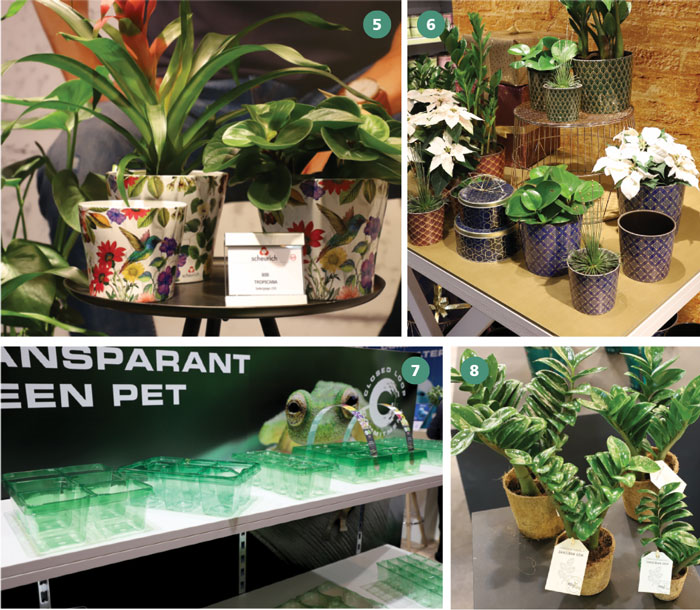
Feldborg’s Three-Pronged Approach
8: Danish foliage grower Feldborg is promoting its sustainable packaging solutions in three parts: 1) Their “Cocoz” biodegradable coco fiber grow pot (which contains some natural rubber for durability and longevity); 2) plant tags made from bamboo and recycled paper (and with the European plant passport planted on it to avoid secondary labeling); and 3) trays made from post-consumer recycled plastic. These Zanzibar Gem Zamioculcas look good in the packaging. (And yes, they say you can actually use the Cocoz pot in a production setting, although they won’t go through a pot destacker.)
New Plants
9: Danish breeder Queen, well-known for beautiful kalanchoes, is adding a hybrid crown of thorns called Euphorbia Grand. A cross between an Asian type and E. milii, this hybrid series offers giant flowers and a sturdy habit. What we liked was that the single stem was protected by foliage, so there were no exposed thorns. Flowers last a long time (these had been flowering for six weeks, we were told!). The line comes in 14 colors, and is a perfect addition for mum or kalanchoe growers.
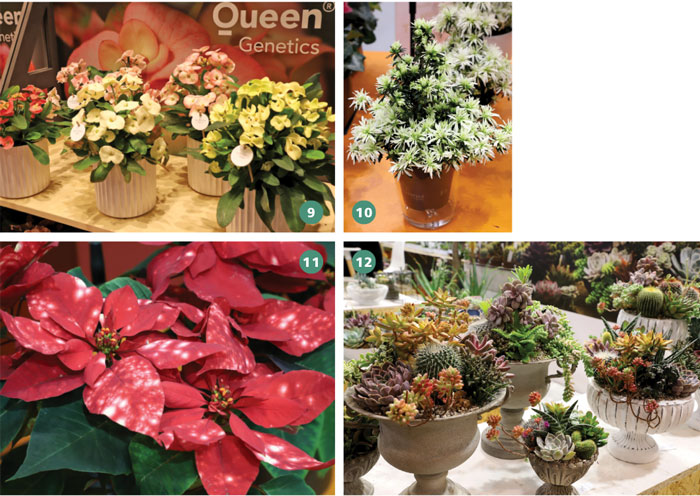 10: “Magisnow” Winter Beauty Rhododendron is a small-leafed azalea that earned the Flowering Pot Plant Novelty Award at IPM. Bred by Belgium’s Hortinno, it’s been trimmed into a Christmas tree shape because it’s perfect for in-home enjoyment from December through February. It starts with buds that resemble Christmas ornaments, which then open into a flurry of snow-white flowers. Hortinno says they have partners in North America, so perhaps it will become available here.
10: “Magisnow” Winter Beauty Rhododendron is a small-leafed azalea that earned the Flowering Pot Plant Novelty Award at IPM. Bred by Belgium’s Hortinno, it’s been trimmed into a Christmas tree shape because it’s perfect for in-home enjoyment from December through February. It starts with buds that resemble Christmas ornaments, which then open into a flurry of snow-white flowers. Hortinno says they have partners in North America, so perhaps it will become available here.
Sky Star Poinsettia
11: Selecta One’s Sky Star Poinsettia offers the same celestial patterning as its Night Sky Petunia. And like Night Sky, it takes the right culture and climate to achieve maximum star power. Sky Star needs cool temperatures (about 62F or lower) during coloring for the sky pattern to develop. (Sorry, southern growers, that pretty much lets you out of the fun.) Sky Star is a nine-week variety with excellent shelf life. Expect a soft launch in North America this year.
Succulent Compositions
12: Compositions is what Italian grower Cactus Mania calls their “crazy” planters, which feature more than 50 different echeveria and other succulents. They’ve helped the company break into the European and Asian markets. While you can’t get their products in North America, we wanted to show their planters as inspiration for your own designs.
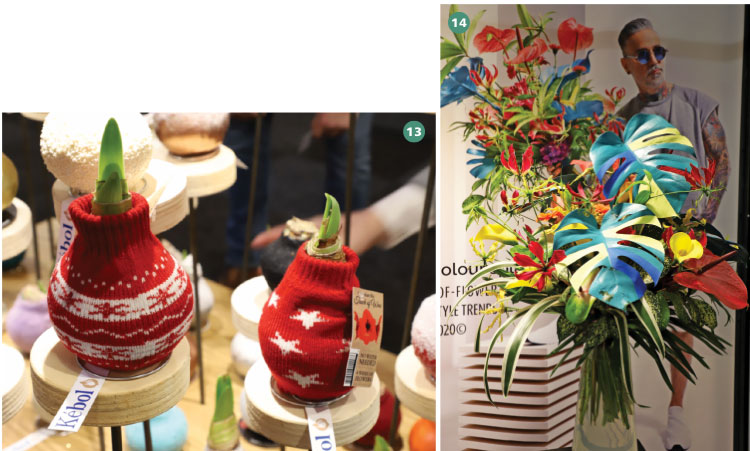
Keep Your Amaryllis Warm and Cozy
13: The clever company Kebol, which has been sealing amaryllis bulbs in colored and decorated wax for several years now, has added sweaters to the line. Seeing how they’re a wintertime product, it only makes sense—we can’t have our amaryllis catching cold at the holidays! Apparently, Kebol’s competitors also have twisted minds (or binoculars), as we saw a similar product in the Breugdenhil stand on their Waxz line.
Street Savage
14: It’s funny: While you won’t see much color in European pottery or home décor, Europeans are NOT afraid of color. To the contrary: Check out this floral arrangement by the wild designers of the German floral association (FDF). It illustrates a style they call “Street Savage.” We’re crazy over those painted monstera leaves.
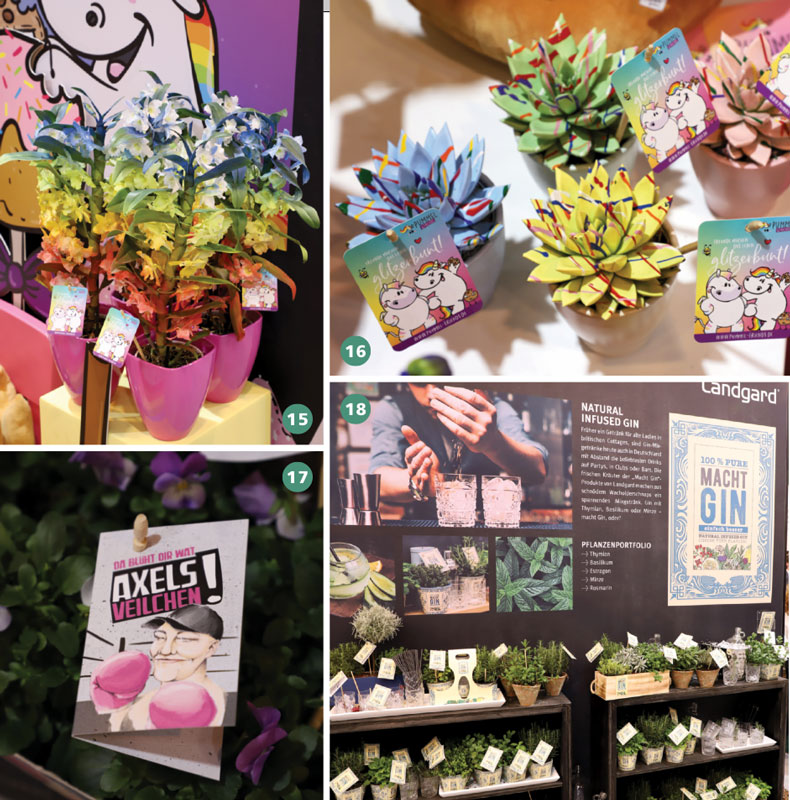
Landgard’s Creative Programs
15-16: The big German plant auction Landgard always impresses us with their plant brands—some of which (Jurassic World and The Minions) must cost them a pretty penny in licensing fees. This year, we loved Pummel & Friends even though we weren’t familiar with Pummel, a colorful, chubby, cookie-eating unicorn who helps kids feel better about being different. Pummel is promoting some extremely colorful and different plants, including painted succulents and dyed dendrobiums.
17-18: Showing that plant programs aren’t just for kids is a barbecue herb and outdoor flower program featuring European boxing champ Axel Schulz (this tag says “Axel’s Violet”) and a “Make Your Own Infused Gin” herb program, complete with instructions on the back of the label.
MANTS
This year’s Mid-Atlantic Nursery Trade Show (MANTS) centered around celebrating its 50th anniversary during the show and the uptick in attendance after all of the numbers were counted. According to the MANTS folks, they had over 12,000 attendees—the highest attendance in 12 years. Attendees from 44 states and 15 countries (including the U.S.) walked the aisles of 968 exhibitors.
Primarily a show for nursery growers and landscapers, the prevalence of “new” products isn’t as prominent as, say, IPM Essen, just because of the nature of the product. Breeding for trees and shrubs takes longer than other plant categories. But there were some trends we spotted while walking around the show.
First, it’s no longer just “ball-and-burlap” you see in the booths—although there is still some of that. But in recent years, MANTS exhibitors have stepped away from the traditional ways of showing nursery products, in favor of displaying, for example, in decorative containers or even decorated like a Christmas tree. And there are more instances of perennials, grasses and even a few annuals.
Second, Dr. Matthew Chappell (University of Georgia professor and editor of our Nursery & Landscape Insider newsletter) noticed there are a lot more native plants than in past years. These suppliers are following what the perennial folks have been touting (think echinacea and asclepias) and customers are asking for them, Matthew said.
A few other observations: more automation; more consolidation leading to more publicly owned nurseries; growers switching from field to container production; and more women in decision-making roles. Robin Rinaca of Eastern Shores Nursery summed it up best: “MANTS has changed a lot, but I’m still selling plants.”
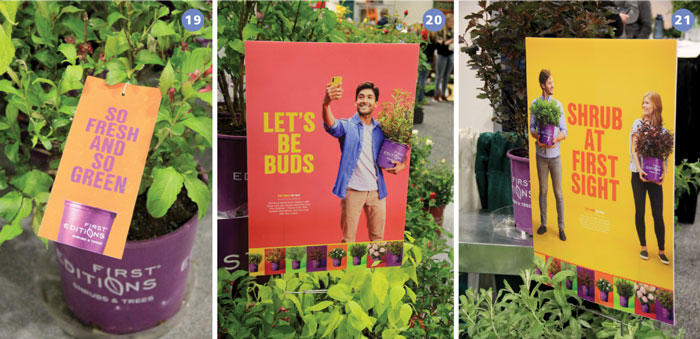
First Editions’ New Look
19-21: Another aspect that’s changed during MANTS’s 50 years is the number of branded products on display and this, we think, coincides with the rest of the industry. This year, Bailey officially unveiled its new branding for their First Editions collection. The simple color palette allows for the clever sayings and images on the signs and plant tags to really stand out (props for the Outkast reference—“So Fresh and So Green”).
“We felt it was an opportunity to solidify the First Editions brand position within a crowded category,” said Alec Charais, Bailey’s Marketing & Communications Manager. “Many brands try to do it all, but because First Editions focuses on shrubs and trees, there are some rock star varieties we want to be sure consumers (as well as retailers, growers and landscapers) know they can be successful with. The rebranding that solidifies First Editions ‘Shrubs & Trees’ is the first step in our positioning so that people can connect with what the brand is all about.”
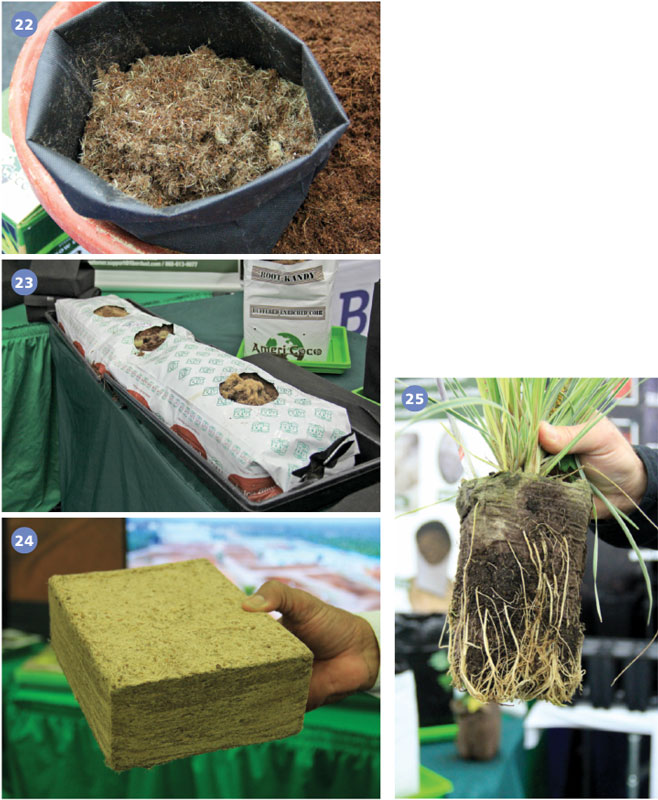
Two Fibers Partner Up
22-24: Like other segments of our industry, the nursery world isn’t immune to the new influences of cannabis and hemp. And many companies are trying to figure out how to capitalize on the craze.
HydraFiber and FibreDust have partnered up to develop a growing media product that’s specifically for growing cannabis (medicinal and recreational) and hemp. There’s no name yet and the patent is still pending, but they’ve been trialing it for a few years with great success, said Sam Ahilan, president of FibreDust.
The wood substrate from HydraFiber that’s made in North Carolina is shipped to India, where it’s mixed with FibreDust’s buffered coconut coir. The final product comes in compressed bags, upright bags and horizontal flat bags in various sizes, which will be available this summer. Since the growing media already comes in bags, there’s no need to reuse containers that need to be sanitized every time, so it saves on labor. FibreDust’s primary customers are berry growers, so this works for them, too.
Retail Ellepots for Nursery and Landscape
25: A few months ago, Bossman Beytes wrote about Ellepot’s new 1-gallon version for retail that he first saw at IPM Essen last year. Danny Takao of Takao Nursery has been trialing them since early last year and had been showing them to local landscapers near his home base of Fresno, California. He received a lot of positive feedback, so he wanted to show some East Coast landscapers to get their thoughts, and MANTS provided a great opportunity to do so.
Lars Jensen, Ellepot’s expert and head promoter, said that, just like smaller Ellepots, the 1-gallon ones save money on the amount of growing media you use and reduces plastic, which also saves you from having to store pallets of pots. Lars said that Ellepots save 40% more space just in storage alone.
Danny said that landscapers, in general, are in favor of reducing their plastic footprint. And handling isn’t an issue since landscapers aren’t, by nature, dirt averse. GT